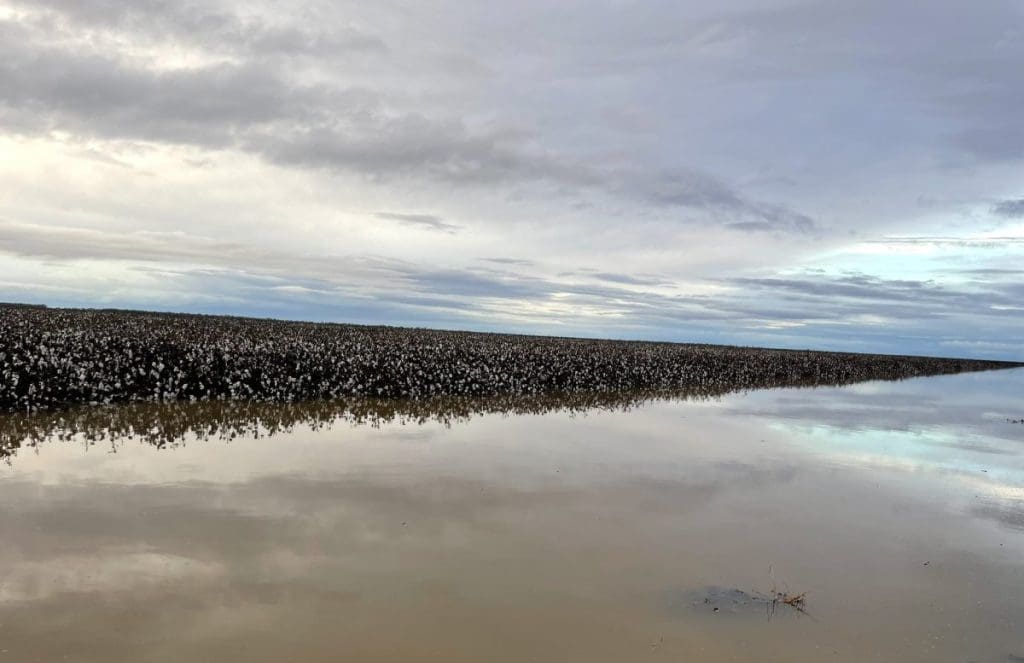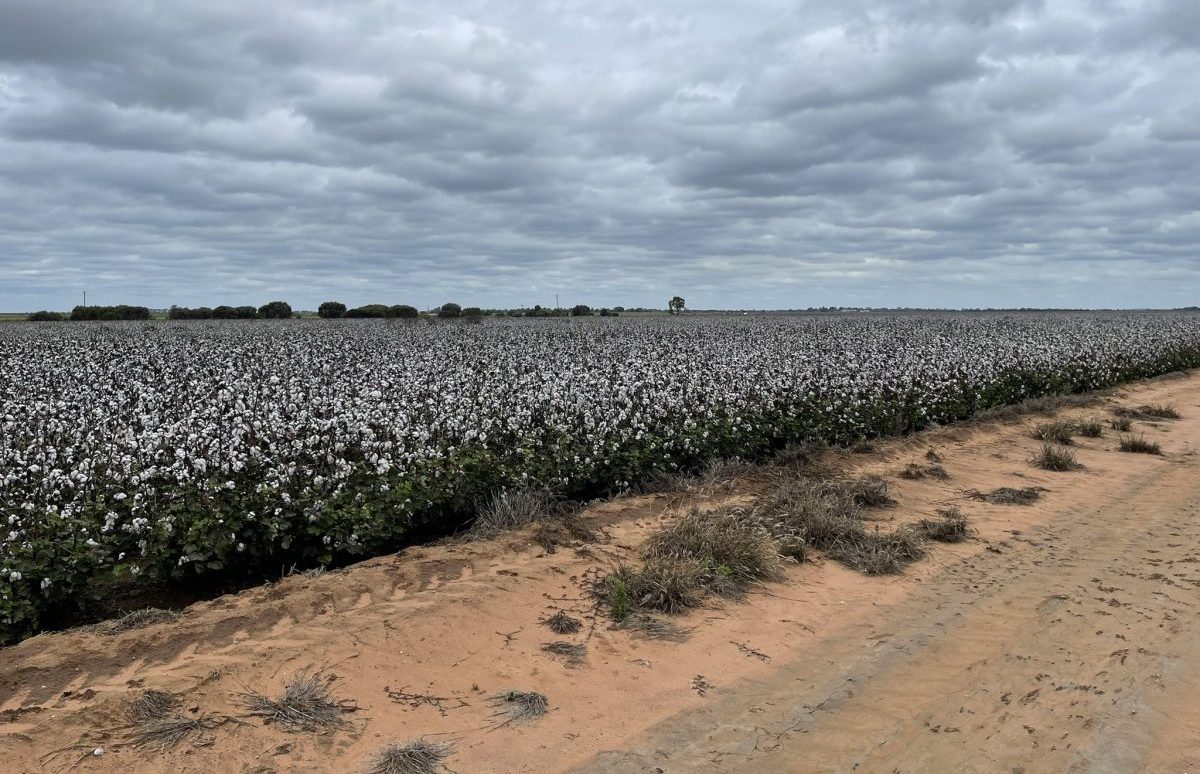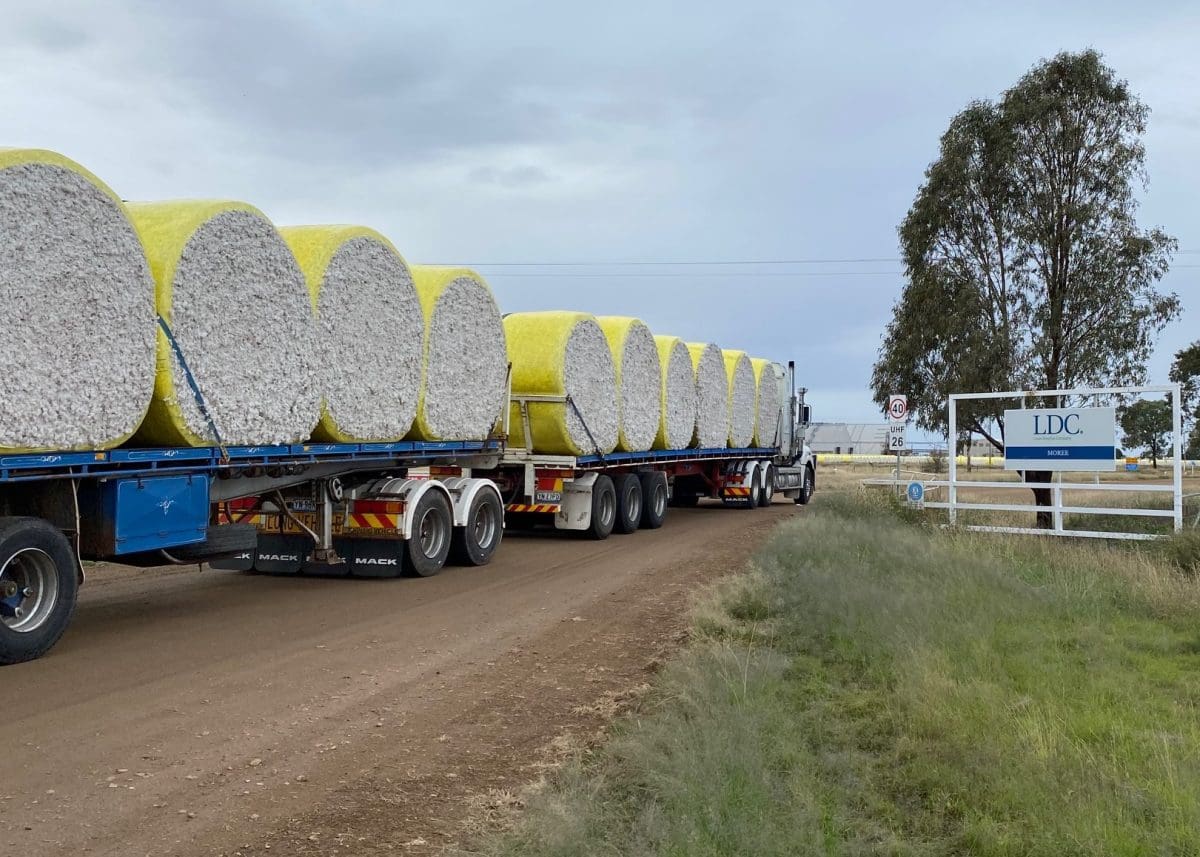
A flood affected cotton crop in the Mungindi region. Photo: South Bunarba Agriculture
Frustrations are mounting as unusually high May rainfall works to delay the harvest further and cause damage to maturing crops.
This comes after some cotton-growing regions experienced up to five flood events over the 2021-22 season,
From Central Queensland (CQ) to northern New South Wales, cotton growers coped falls of over 100 millimetres last week, with most not able to step foot on their fields for several days.
For some regions this rainfall was just one of several flooding events to hit their crops this year.
Dalby dryland and irrigated cotton grower, Dan Hayllor, said the continuous, heavy falls from earlier this year until recently have caused major damage and downgrades to his crop.
“We have had significant damage from rain,” Mr Hayllor said.
“From February on we have had a massive amount of boll rot and, because of the rain and cloudy weather, we have had shedding.
“Some paddocks for us we have lost 30 bolls a metre and that is not including what we have shed.
“From there, with the crop open, that has obviously had a fair impact on colour, so we are looking at some fairly significant downgrading as well once we get the pickers rolling.”
Dryland fares better
Mr Hayllor said there is a clear difference between the dryland and irrigated crops, with the dryland showing more resilience in the face of ongoing rainfall and reduced sunlight.
“Dryland is exceptional; it is handled the rain a lot better.
“We have minimal boll rot and damage there and it’s going to grow very well.
“But, irrigation, I think most people will say it is pretty disappointing.”
Cotton Australia Darling Downs regional manager Janet Barker said for most growers in her region, it was still too early to tell the extent of the damage.
“It is hard to tell about damage until it goes through the gin and they can see what the quality of the cotton is like,” Ms Barker said.
“Wet weather generally causes downgrades because of boll rot and mould, but the extent of it no one will really know at this stage.”
Ms Barker said overall the Downs was already looking at longer cotton season than normal, with many growers delaying planting or making the decision to replant significantly damaged crop.
“It was planted late, and it has been cooler, so most growers haven’t picked their cotton yet and a lot of it isn’t ready to pick.
“A lot of people who planted dryland cotton, it has been harvested because they planted early and they were able to get some of it off.
“The irrigated stuff is wet and not ready.”
CQ gets big wet
Like some of their Downs counterparts, most CQ cotton growers delayed planting their 2021-22 crop; however, this was due to lack of rainfall rather than too much water.
Suffering the opposite affects of the La Niña weather system, these growers had little to no wet season, making the recent winter rainfall, a welcome – if ill-timed – relief.
Central Highlands Cotton Growers’ and Irrigators Association president Danni Ingram said her Emerald property recorded more than 100mm this month.
She said thankfully her crop wasn’t ready to pick, but others in the region were in the middle of harvest.
“The crop has survived a lot better than I thought; there wasn’t a lot of cotton on the ground, there wasn’t a lot of tight lock, and the cotton didn’t have any mould,” Ms Ingram said.
“I wasn’t able to go the full way through the farm, but I was pleasantly surprised with how well it handled the rain.”
Ms Ingram said she expected to see delays of 10-14 days while growers wait for soaked fields to dry enough to accommodate a picker.
“Generally, after a reasonable amount of rainfall and depending on the weather, we are anywhere from 10 days to two weeks from seeing machinery on the ground.
“It’s been cooler as well and we have been getting a few heavy dews as well which I am finding keep everything delayed.”

Farmers in Central Queensland who had commenced harvest before the recent rain events experienced crop downgrades and yield reductions. Photo: Queensland Farmers Federation.
Unlike Ms Ingram, Emerald grower Aaron Kiely had commenced picking when rain halted the harvest operations.
“We had started picking and probably are an eighth of the way through,” Mr Kiely said.
“With this constant weather there will be damage to colour and there will be slight damage if it keeps hanging around.”
Mr Kiely said he would have started harvesting at least three weeks ago, but the continuous rainfall and drenched soils kept pickers off the paddocks.
Ms Ingram said the 2021-22 has been unusual for CQ growers who were keen for a return to more normal rainfall after four years of drought conditions.
“May is not a typical month that we have high rainfall.
“Normally we get summer storm rain starting in October, November, December then better rainfall between January, February, March.
“We really missed the rain this year; a lot of places have had it, but Emerald has not been one of them except for now.”
NSW picking halted
Growers across the border in northern NSW weren’t spared the high May rainfall.
Mungindi Water Users’ and Cotton Growers’ Association president Tristram Hertslet said some growers in his region recorded rainfall closer to the 200mm mark in recent weeks.
While the Mungindi region was further through picking than the Downs, Mr Hertslet said the wet weather will cause major delays in finishing the harvest.
He said at this stage about 50 per cent of cotton was picked in the area.
“It has stopped everything at the moment; we are just waiting for everything to dry up before we can get back on the paddocks,” Mr Hertslet said last week.
“We started picking at a reasonable time, because we had that warm weather and a pretty good finish.
“It was good to be able to get going when we did, but just need a bit more time now to get the rest off.
“It is going to make it hard with that much rain and river heights up.
“We are just holding our breath that is not going to rain again.
“This is the fifth flood event for the last 12 months; it’s getting a bit testing.”

Bales arrive at LDC’s Moree gin on Saturday. Photo: Henry Wells
Mr Hertslet said early reports indicated that cotton now being being harvested was high quality and yielding before the rain event.
“The yields were holding up well.
“It was picking well, picking clean and the quality was there.”
The Bureau of Meteorology last week predicted that most of the Australian mainland will see above median rainfall from June to August.
Most model outlooks indicate that the La Niña weather pattern, which is driving most of this rainfall, will subside by July.
Grain Central: Get our free news straight to your inbox – Click here

HAVE YOUR SAY